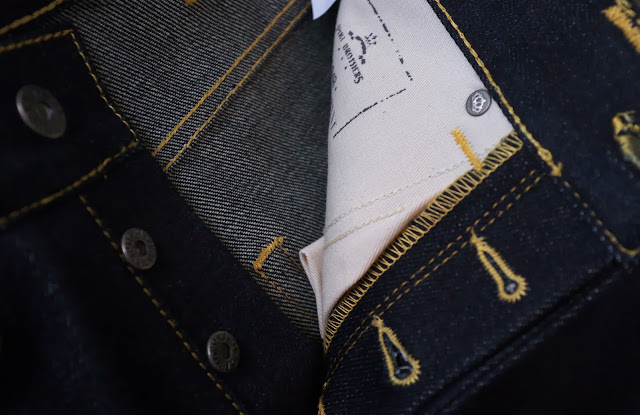Japanese Denim, German Engineering.

Taking their inspiration from both European and American workwear, Pike Brothers focus on making beautiful authentic clothes, eschewing trends that seem to govern most of the denim industry in favour of simply producing what they like. This makes them a firm favourite of mine.
Most of Pike Brothers’ other denim is only 11 oz, a trifle light by selvedge standards. However, they did cause a bit of a stir with the uber heavy 23oz 1958 Roamer Pants, and this is where the inspiration for the 1948’s came from.
As Pike Brothers’ founder, Fabian Jedlitschka, says, “we had several people asking for a little bit lighter version and a wider fit.”
Clearly I wasn’t alone in wanting them to do something in between the two, with a cut closer to the 1937 Roamers.
As their regular mill in Turkey is only capable of working with denim up to 16oz, Pike Brothers had to turn elsewhere.
For Fabian only Kurabo in Japan could deliver the quality needed.
Simply put these jeans are a thing of beauty. Fabricated from 19oz right hand twill raw selvedge denim they’re satisfyingly heavy.
The indigo really is quite a deep, well, indigo. The contrasting blue and golden stitching on the selvedge, replicated again on the coin pocket, is a great touch.
 |
| Selvedge detail on the coin pocket |
At 19oz I was interested to find out whether these jeans presented any of the same production problems as the 23oz Roamers, “production was a bit more difficult. We had to sew the denims a bit slower not to risk any needle damages but besides that it wasn't too bad.”
The 1948 Roamer has lost the cinch and brace buttons of their 1937 cousin.
Fabian argues that by 1948 manufacturers had ditched these in favour of belt loops, “we looked at our archive and also studied pictures from the 40s and decided not to outfit the 1948 with suspender buttons and a cinch. These features are hardly found during that era.”
By way of comparison the 501 lost its brace buttons in 1937, younger workmen preferring to sport a belt.
 |
| D ring for your watch or wallet chain |
In cut the 48’s retain an authentic "anti fit" feel, with a decent rise and a wide, un-tapered leg, again entirely accurate for the era.
All the details you expect to see from Pike Brothers are present and correct - the honey yellow stitching, the heavy bar tacked belt loops, seam ends and pockets.
As is the lock stitched hem. In an earlier interview with Denimhunters, Fabian argued that European work wear manufacturers would not have had access to Union sewing machines capable of chain stitching. Maybe an issue for some people, but I don’t see a problem.
 |
| Lock-stitched hem |
My one quibble is that it would have been nice to see Pike Brothers dispense with the light zinc finish buttons and rivets in favour of something worthy of such heavy denim. In all other respects they’ve gone the extra mile with these jeans. A minor point though. The quality of this Kurabo denim is such that it’s not a deal breaker.
 |
| Maybe too light? Zinc buttons.. |
Pike Brothers recommend that you break in the jeans from dry. It’s been covered before in the Denimhunters Rinse Guide, but I always give raw denim a pre wear soak. Not only will a soak make your denim last longer, it will prevent them shrinking after the first wash.
There’s not much point investing months of your time breaking in such beautiful jeans only to have them not fit you afterwards.
That said, post soak the jeans had lost only an inch off the leg. The waist stretched by just 3/4 of an inch.
I’m genuinely excited at the prospect of breaking these in over the next few months. At 19oz this will take some work, (just buttoning the fly is a challenge), but that’s why we love raw denim, right? Thank Christ it’s winter though, these baby’s are heavy!
Pike Brothers have surpassed themselves here. Clearly a lot of hard work went in to developing the 1948 Roamar Pant, and the end results are impressive in almost every way. Tempted? You should be.
(With thanks to Fabian & Olivia at Pike Brothers for letting me try them out on behalf of Denimhunters)
























